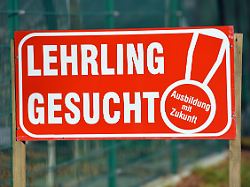Study dispels myths
Crowds at universities do not explain the shortage of trainees
November 16, 2023, 2:33 p.m
Listen to article
This audio version was artificially generated. More info | Send feedback
According to a Bertelsmann study, the fact that so many apprenticeship positions remain unfilled is not just because more school leavers are deciding to study. The number of students has also fallen. Other assumptions are also wrong.
According to a study, the current shortage of trainees cannot be explained solely by the growing popularity of studying. The problems on the training market have worsened in the last five years, but during this time there has been no further increase in student numbers, explained the Bertelsmann Foundation. She also wants to use the study to dispel other “myths” about training and studying.
Between 2011 and 2021, both the number of new trainees per year fell (from 733,000 to 660,000) and the number of new students (from 519,000 to 470,000), according to the Bertelsmann Foundation. The demographic decline affects not only professional training, but also academic training. In addition, none of the three professional groups with the highest proportion of unfilled training positions – plumbers, specialist food salespeople and butchers – are in direct competition with academic courses.
Career career not set in stone
The statement that almost all students have now completed their Abitur is also incorrect: According to the researchers, it is true that the number has increased significantly compared to the 1960s – but this is in response to international criticism and academic bottlenecks of the 2000s. However, there has been no significant increase in the number of people eligible to study for ten years. According to the study by the Bertelsmann Foundation and the Center for University Development (CHE), other common assumptions are also wrong.
After school, young people have to decide between studying and training – after which their future career path is finally determined: “This misconception persists, but it is simply not true,” explained Ulrich Müller from CHE. There are increasing transitions in post-school education – in both directions. The dual study program is an approach that combines vocational and academic education. The career path after school is not determined once and for all. “It is always possible to later adapt the chosen educational path to changing goals,” emphasized the researchers. The education system has become more flexible and permeable in recent years.
It’s not just academics who earn really well
When it comes to money, the researchers also contradict what they believe to be a widespread assumption: the statement “Only academics earn really well” is not true in this blanket statement. Vocational training could lead to similarly high wages. Statistically speaking, an employee with a degree earns more on average than someone with vocational training – but no more than someone with a technical school diploma, a master craftsman or a technician. The German Chamber of Commerce and Industry (DIHK) added that training followed by further training provides better protection against unemployment than studying. The DIHK emphasized that it is right not to play the two career paths off against each other.
At the same time, it remains important “that even more young people and their parents realize that the path to professional success does not necessarily have to lead through studying.” “Misinformation about studies and training can lead to wrong decisions,” explained Caroline Schnelle from the Bertelsmann Foundation. For the young people themselves, this leads to great frustration, missed opportunities and the feeling of having wasted time and energy. In view of the shortage of skilled workers, it is important for society as a whole to provide young people with the best possible support in choosing the right career. “No one should be lost in the transition from school to work.”
